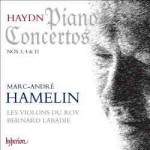 Joseph Haydn. Piano Concertos Nos 3, 4 & 11. Marc-André Hamelin (piano), Les Violons du Roy, Bernard Labadie (conductor). Hyperion,
Joseph Haydn. Piano Concertos Nos 3, 4 & 11. Marc-André Hamelin (piano), Les Violons du Roy, Bernard Labadie (conductor). Hyperion,
Marc-André Hamelin’s latest piano album, his fifty-somethingth for Hyperion, is the second stage in his journey through Haydn’s keyboard music. The first stage was a companionable, dramatic, three album solo set of the Piano Sonatas. Now Hamelin has enriched the mix with the addition of Bernard Labadie and his award-winning chamber ensemble in presenting Haydn’s wondefully warm piano concertos. Their collaboration on these three of Haydn’s eleven Concertos for Keyboard pays attention to details of articulation while enjoying freedom to interpret the sketchily notated scores.
The album starts sprightly with Haydn’s well-known Keyboard Concerto No. 11 in D major (Hob. XVIII/11) 1779 -’83. The crystalline tones and crisp edges of Hamelin’s keyboard sparkle across the swelling orchestral surface. His tasteful choices in modulating rhythm, tempo and rests emphasize the wit of Haydn’s mind. The second movement, adagio, has a kind of ‘Elvira Madigan’ sweetness with murmurs of ‘Moonlight Sonata’ in the accompaniment. There is mischief in the final rondo, famed for the piquant chromaticisms of its gypsy origins.
The Concerto in F major, Hob.XVIII:3 1765-67, is a much earlier work but the transparency of musical intelligence shared by composer and interpreters is everywhere evident. The opening is stately and in the orchestra part you can hear deep feeling close to sadness. In the first two movements the keyboard and orchestra move much in imitation, and Hamelin supplies his own cadenzas. The interpretation is nocturnal, reflective and moony, with less sparkle and more warm glow in the piano.
Bernard Labadie and the Orchestra set the tempo and mood of restrained elegance in the Concerto in G major, Hob.XVIII:4 1770. The orchestral part seems to enfold the nimbleness and wit of the high-stepping solo piano. The orchestral textures of the Adagio extend into a funereal lament and out of that the piano emerges with the dignity of a childbride. The mood shifts from sadness to sweetness and to smiles in the Presto final rondo. All three cadenzas here by Hamelin contribute a pleasant air of freedom that skips over the surface of these concertos.
Hamelin characterizes these concertos as “music that mainly aims to please.” And please they do, much and often.
